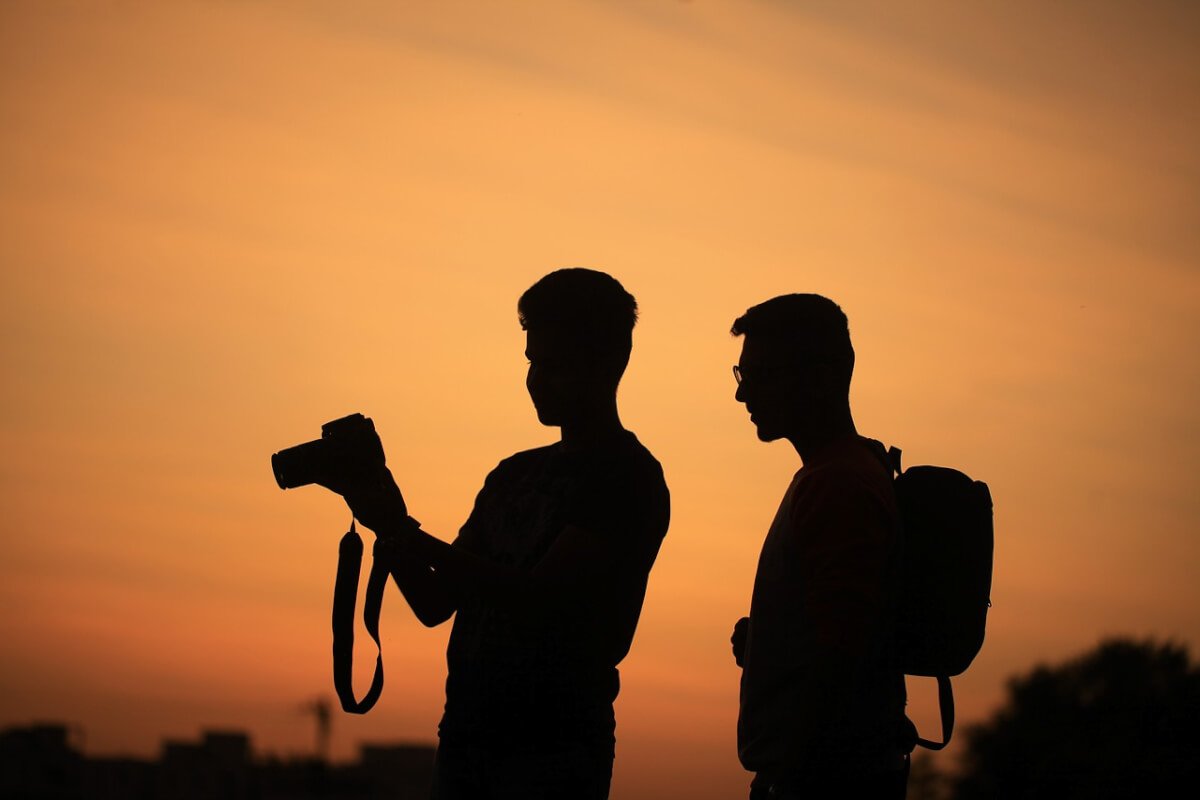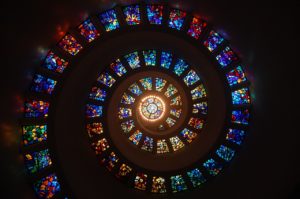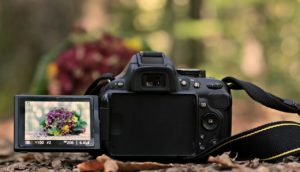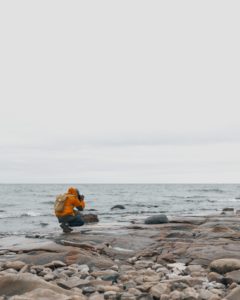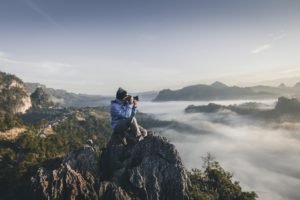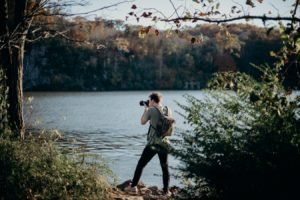The light from even a small flash is as powerful as the sun but, given that it’s only source of energy is a small battery, it can only produce this amount of light for an extremely small period of time – less than 1/1000th of a second. The actual length of time the flash fires for is very carefully controlled by your camera. During a flash exposure, your camera constantly monitors the amount of light reaching the image sensor and shuts off the flash as soon as the picture is exposed correctly.
It has to do this because the light from a small flash falls off dramatically the further away you are. In fact, it falls off with the square of the distance. That means if you moved your subject twice as far away, you would need four times as much light, 3 times further away requires 9 times the amount of light.
But you don’t need to know that because your camera will do all that for you automatically. If you did move your subject 3 times further away the flash duration would simply be 9 times longer. This would still be an extremely short time and you probably wouldn’t notice the difference. What you might notice is that the flash would take longer to recharge because it had used up so much power.
The very first flashguns were entirely manual and photographers had to do long calculations to determine the correct exposure when using flash. Studio flash units still work this way but most photographers now use flash meters to avoid having to do all this calculating.
So your flashgun will automatically compensate for the distance of your subject and give you a perfectly exposed picture every time – what could possibly go wrong?
Out of range
Although your flash will compensate for the subject’s distance, it has its limits. It only has a certain amount of power and this translates into a maximum distance for your subject. If you try to take a flash picture from any further away, it will just be too dark or underexposed. Your camera’s manual should tell you what the maximum subject distance is for flash photography is. In small cameras it is typically 12-15 feet.
It is often expressed as a range of distances rather than a single absolute figure because the conditions under which you are taking the photograph will have an effect on this maximum distance. For example, When you take a picture indoors the light from the flash not only goes directly to the subject but also lights up the whole room. The light that hits the walls and ceiling then bounces off them and adds to the light landing on your subject.
Compare that situation with taking a flash picture outdoors at night. The light that doesn’t reach your subject directly has nothing to bounce off, so overall, less light will land on your subject. Whilst your camera’s flash might be able to compensate perfectly well for this, it will reduce the maximum distance for flash photography compared with taking pictures indoors.
Of course, indoors can mean a tiny room or an enormous one. So, if you are taking your photograph in a baronial banqueting hall with very dark walls and a high ceiling, you could be approaching the same situation as you have outdoors and the maximum distance for flash would be reduced.
What this means in practical terms is that if you have just taken a flash picture and it looks too dark, just get closer and try again. That will usually solve the problem.
Don’t get too close
There is also a minimum distance for which you can successfully use flash. As your subject gets closer and closer, the flash duration gets shorter and shorter. Eventually, you will reach the limit of how quick the flash can be. In practical terms, this translates into a minimum distance for flash photography with your camera.
I’m sure all of you will have seen pictures of people taken with flash where their faces were bleached out and they look like ghosts. That’s what happens if you get too close with a flash gun. Again, your camera’s manual should give you the minimum flash distance for your particular camera.
If you can’t find the information about maximum and minimum flash distances you could always do a few test shots and measure it for yourself. As a general guideline, if your subject is between 6 and 12 feet away, you should be all right.
In the real world
Of course, in reality there will be a lot more in your photograph than just the subject. There will be something behind your subject in the background and there may well be something else in the foreground. This is where flash photography gets complicated. The fact is, that even if your camera works out the correct exposure for your subject’s distance, it’s only correct for that distance. Anything closer or further away will actually get the wrong exposure.
It’s relative distance that matters here. For instance, if you are taking a photograph of someone who is standing quite close and holding their hands out towards the camera, their hands will, relatively speaking, be much nearer to the camera. Two things can happen here. Either the hands or what they are holding will be far too bright (overexposed) or the camera will set the exposure correctly for the hands and the subject’s face will be too dark.
The cure for this is to move further away from your subject. Whilst their hands and face will obviously be the same physical distance apart, this will be relatively less than the distance to the camera and that’s what affects the exposure.
Exactly the same thing happens if your shot contains more than one person or other subject. If they are far apart in terms of distance from the camera then the nearest one will be very much brighter than the one farthest away.
You may have taken a flash picture of someone in a very large room and been surprised to find that the background extremely dark, much darker than it looked in real life. This is again the effect of relative distance. If the background is a long way behind your subject then it will not receive much light from the flash.
The opposite is also true. If you take a flash photograph of someone standing against a wall then the wall will get the same amount of light as the subject. This can be distracting, especially if the wall has interesting features. It can look as though your subject is somehow “stuck” onto the wall. It is usually better if the background is a little darker than the subject of the photograph.
What’s different about flash photography?
Many people notice that the picture they take with flash looks completely different from what they see when they look through the camera. This is perfectly normal, and here’s why.
What we actually see is light. When we look at anything what we see is the light that bounced off it towards our eyes. The direction and quality of the light defines the way everything looks to us. In this respect the camera is no different. If we didn’t use flash then the photograph would look much more like what we actually see. Of course, we can see perfectly well in light that is far too dim for a camera, and that’s why we need flash.
The light from a flash, being as bright as the sun, will totally overwhelm any other light sources in a room. The scene changes from being lit by, for example, a window off to one side and a few indoor lamps to one being lit by a very bright light placed very near to the camera lens. We never see the scene this way, only the camera does. That’s why the flash picture can look completely different. Just imagine switching on an extremely bright spotlight in a small room and how that would change the way the room looks.
That is also why studio flash units have a “modelling” light, so the photographer can see the effect of using flash before they take the photograph. Built in flash guns do not have this option.
Practical tips
The ideal situation for taking photographs using your built in flash is as follows:
1. The subject of your photograph should be between 6 and 12 feet (2-4 metres) away from the camera.
2. The background should be the same distance behind your subject.
3. If there is more than one subject, make sure they are all in a line at the same distance from the camera.
4. Check that there is nothing in the foreground of your shot that is significantly closer to the camera than your subject.
I hope the above has given you some insight into the effect of using the built in flash on your camera. I certainly hope that it hasn’t put you off using flash because, with a little planning, you can produce excellent flash pictures every time.
Submitted by:Colin AikenColin Aiken is a professional photographer based in the United Kingdom. You can view some of his photographs and get more tips at: http://www.lovethepictures.co.uk |

